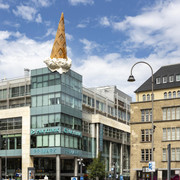Photos & Map
How would you like to arrive?
Details
Useful Information
Nearby
The beating heart of Cologne’s shopping world
He sings, he shouts, he provokes — while playing the fiddle in his bib and brace overalls. For decades, you could often encounter Klaus the Fiddler, Germany’s best-known street musician, on Cologne’s Number 1 shopping street, Schildergasse.It is a broad pedestrian zone featuring traditional shops such as the Riese confectioner's and modern shops, as well as a wide range of street musicians, cafés and snack stops. Every day, as many as 70,000 people stroll along this route. That’s good for Cologne’s economy — and for the hats put out by the street musicians.
Cologne’s second-oldest street, Europe’s favourite shopping mile
Schildergasse is 534 metres long and leads from Neumarkt (New Market) to Cologne’s second major shopping mile, Hohe Straße. And under these pavements there’s a lot more than meets the eye: 2,000 years of history. Many interesting aspects come together here. That’s typical of Cologne.Facades that still tell a story: Stories from Schildergasse
Schildergasse was a street for shopping and strolling for a long time before it became a pedestrian zone in 1966. For example, the chocolate manufacturer Franz Stollwerck opened his Café Royal here in 1847. The first cinema in Cologne was on Schildergasse. The city’s biggest and most modern department store, Kaufhaus Tietz, was opened at the corner of Schildergasse and Hohe Straße in 1914. When the city was rebuilt after the Second World War, this department store was replaced by Galeria.Stories that you can discover are written behind many of the façades on Schildergasse. Many visual highlights can also be found if you lift your gaze above the shop windows. An example is the sweeping curve of the Weltstadthaus designed by Renzo Piano, which many have compared to a glass whale.
Historical and medieval concepts are already embedded in the name of Schildergasse, which refers to the artists, painters, sculptors, and creators of coats of arms and shop signs who used to live and work along and around Europe’s favourite shopping mile.
Beer Fountain: In memory of the Brewers’ Guild Hall
At the fork in the road that splits into Schildergasse and Gürzenichstraße you’ll come upon a square that features an eight-metre-high granite column. If you give it a closer look, it will turn out to be a fountain. It was meant to remind passersby of the Brewers’ Guild Hall, which used to stand a few metres away until 1927, and it offers plenty of room for artistic interpretation.It used to be possible to draw a glass of Kölsch beer here on certain occasions, thanks to an underground pipe leading to a nearby beer wagon. That explains yet another name: the Beer Fountain. Today, if you’re looking for a fresh glass of Kölsch, you’ll have to go to the next brewery or the next pub.
Between commotion and consumption: A place of serenity and reflection
Depending on the day of the week and time of day, Schildergasse can become quite crowded. If you then need to take a break and have some quiet time, you can spend a few minutes in the Antoniterkirche (Antonine Church), which is located approximately at the midpoint of Schildergasse, directly beside the Weltstadthaus. Here you can leave the world outside, escape the summer heat or attend a ten-minute prayer service.The story behind the Barlach angel is incredible and moving
The Antoniterkirche was the first Protestant church in Cologne, and it’s probably the most frequently visited church in the city after the cathedral. Hovering above the side altar is the “floating angel” or “Barlach angel”, which was created by Ernst Barlach to commemorate the soldiers who fell in the First World War. But the story behind the angel goes even further. The National Socialists melted the sculpture down, defamed it as “degenerate art”, and used the metal to produce armaments. However, friends of Barlach were able to save the original plaster model, secretly create a second cast and hide it. Bombs destroyed the plaster model in 1943/1944 — but after the war the second cast found its way back to the Antoniterkirche in Cologne. The congregation collected 10,000 deutschmarks for this purpose, which was an astonishing amount in the postwar period. The angel is a fine object of contemplation for the next time you walk along Schildergasse.Useful Information
Openings
Please note the individual opening hours of the stores. Most stores are open on weekdays between 10 am and 8 pm.
General Information
Parking Available
Bus stop available
Eligibility
for families
for individual guests
Parking facilities
From Cologne Cathedral you can reach Schildergasse on foot via Hohe Straße or take a tram lines 16 or 18 to the Neumarkt stop.
Nearby










